Space debris

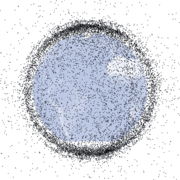
Space debris (also known as orbital debris, space junk, and space waste) is the collection of objects in orbit around Earth that were created by humans but no longer serve any useful purpose. These objects consist of everything from spent rocket stages and defunct satellites to explosion and collision fragments. The debris can include slag and dust from solid rocket motors, surface degradation products such as paint flakes, coolant released by RORSAT nuclear powered satellites, clusters of small needles, and objects released due to the impact of micrometeoroids or fairly small debris onto spacecraft.[1] As the orbits of these objects often overlap the trajectories of spacecraft, debris is a potential collision risk.
The vast majority of the estimated tens of millions of pieces of space debris are small particles, like paint flakes and solid rocket fuel slag. Impacts of these particles cause erosive damage, similar to sandblasting. The majority of this damage can be mitigated through the use of a technique originally developed to protect spacecraft from micrometeorites, by adding a thin layer of metal foil outside of the main spacecraft body. Impacts take place at such high velocities that the debris is vaporized when it collides with the foil, and the resulting plasma spreads out quickly enough that it does not cause serious damage to the inner wall. However, not all parts of a spacecraft may be protected in this manner, i.e. solar panels and optical devices (such as telescopes, or star trackers), and these components are subject to constant wear by debris and micrometeorites.
The present means for spacecraft shielding, such as those used for the manned modules of the International Space Station, are only capable of protecting against debris with diameters below about 1 centimetre (0.39 in). The only remaining means of protection would be to maneuver the spacecraft in order to avoid a collision. This, however, requires that the orbit of the respective object be precisely known. The current equipment used to gather such information is only capable of tracking objects down to about 5 centimetres (2.0 in) diameter in low Earth orbit, and about 50 centimetres (20 in) in geosynchronous orbit. Out of the estimated 600,000 objects[1] above 1 centimetre (0.39 in) diameter, only 19,000 can be tracked as of today. This leads to wide uncertainties in the estimated quantities of debris, and the predicted path of their orbits.
If a collision with larger debris does occur, many of the resulting fragments from the damaged spacecraft will also be in the 1 kilogram (2.2 lb) mass range, and these objects become an additional collision risk. As the chance of collision is a function of the number of objects in space, there is a critical density where the creation of new debris occurs faster than the various natural forces that remove these objects from orbit. Beyond this point a runaway chain reaction can occur that quickly reduces all objects in orbit to debris in a period of years or months. This possibility is known as the "Kessler Syndrome", and there is debate as to whether or not this critical density has already been reached in certain orbital bands.
Contents |
History
Micrometeorites
In 1946, during the Giacobinid meteor shower, Helmut Landsberg collected several small magnetic particles that apparently were associated with the shower.[2] Fred Whipple was intrigued by this and wrote a paper that demonstrated that particles of this size were too small to maintain their velocity when they encountered the upper atmosphere. Instead, they would quickly decelerate and then fall to Earth unmelted. In order to classify these sorts of objects, he coined the term "micro-meteorites".[3]
This early work, in collaboration with Fletcher Watson, led the Harvard Observatory to build a station observatory to directly measure the velocity of the meteors that could be seen. At the time some argued that meteors were extra-solar in origin, while others claimed they were leftovers from the formation of the solar system. These direct measurements were able to locate the source of the meteors, demonstrating that the bulk of material was leftover from comet tails, and that none of it could be demonstrated to have an extra-solar origin.[4] Today it is understood that meteors of all sorts are leftover material from the formation of the solar system, part of the interplanetary dust cloud or the various other objects made up from this material, like comets.[5]
These studies were based on optical measures only. In 1957 Hans Pettersson conducted one of the first direct measurements of the fall of space dust on the Earth, estimating it to be 14,300,000 tons per year.[6] If this were true, then the meteor flux in space was much higher than what the telescopes were seeing. If true, meteors would present a very serious risk to missions deeper in space, specifically the high-orbiting Apollo capsules. To determine which measure was more accurate, a number of additional studies followed, including the Pegasus satellite program. These showed that the flux in line with the optical measures, around 10,000 to 20,000 tons per year.[7]
Micrometeorite shielding
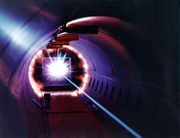
Although Whipple's work pre-dated the space race, it proved useful when space exploration started only a few years later. This work had demonstrated that the chance of being hit by a larger meteor, large enough to destroy a spacecraft, was extremely remote. However, it also demonstrated that a spacecraft would be hit by micrometeorites, about the size of dust grains, almost constantly. Early attempts to protect spacecraft against these micrometeorites generally employed a brute-force approach, which used an outer wall that was thick enough to protect the spacecraft from these sorts of impacts. This was generally far thicker than what was needed for the spacecraft's mechanical structure. Since spacecraft launch costs are a direct relation to their mass, this was an expensive solution.
A better solution had already been developed by Whipple in 1946.[8] Originally known as a "meteor bumper", what is today known as the Whipple shield consisted of a thin foil film held a short distance away from the spacecraft's body. When a micrometeorite hit the foil it would be vaporized into a plasma that would quickly spread out. By the time the plasma crossed the short distance between the shield and the spacecraft, it would be so diffuse that it would not be able to penetrate the structural material below. This allowed the spacecraft body to be built to whatever thickness was needed just for its own structural needs, while the foil would add little additional weight. For spacecraft that spend the majority of their time in orbit, some variety of the Whipple shield has been almost universal for decades.[9]
Kessler's asteroid study
As space missions moved out from the Earth and into deep space, the question arose about the environment of the asteroid belt, which probes would have to pass through on voyages to the outer solar system. Although Whipple had demonstrated that the near-Earth environment was not a problem for space travel, the same depth of analysis had not been applied to the belt. Into this void stepped Donald Kessler, who published a series of papers, starting in late 1968, estimating the density of asteroids.[10][11]
This work led to a 1971 paper on the dynamics of the asteroid system and its evolution over time.[11] Kessler started with the observation that large objects in the belt would eventually be pulled onto collision courses by the actions of the other planets, notably Jupiter. When they collided, a spray of material would be ejected that would lie in a range of new orbital paths similar to the original pre-impact orbit. Since these new orbits overlapped, the objects would then be subject to collisions between each other, and since there were more of them, subsequent impacts would increase in frequency. This ablation cascade process would continue, reducing the size of the objects over time. Based on the measured sizes of known asteroids, Kessler was able to demonstrate that this time scale was in the order of billions of years. This being the case, the density of small debris would be fairly low.
The main outcome of the study was the demonstration that transiting the asteroid belt was not particularly dangerous.[11] The Pioneer and Voyager missions successfully transited this region only a few years later.
NORAD, Gabbard and Kessler
Since the earliest days of the space race, the North American Aerospace Defense Command (NORAD) had maintained a database of all known rocket launches and the various objects that reach orbit as a result – not just the satellites themselves, but the aerodynamic shields that protected them during launch, upper stage booster rockets that placed them in orbit, and in some cases, the lower stages as well. Known as the Space Object Catalog when it was created with the launch of Sputnik in 1957, NASA later started publishing data-massaged versions of the database in the now common two-line element set format.[12]
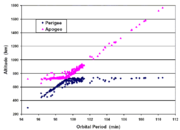
The trackers that fed the database were also aware of a number of other objects in orbit, many of which were the results of on-orbit explosions.[13] Some of these were deliberately caused as a part of 1960's anti-satellite weapon (ASAT) testing, while others were the result of rocket boosters that had "blown up" in orbit as leftover fuel expanded into a gas and ruptured their tanks. Since these objects were only being tracked in a haphazard way, a NORAD employee, John Gabbard, took it upon himself to keep a separate database of as many of these objects as he could. Studying the results of these explosions, Gabbard developed a new technique for predicting the orbital paths of their products. "Gabbard diagrams" (or plots) are widely used today. Along with Preston Landry, these studies were used to dramatically improve the modelling of orbital evolution and decay.
When NORAD's database first became publicly available in the 1970s, Kessler applied the same basic technique developed for the asteroid belt study to the database of known objects. In 1978, Kessler and Burton Cour-Palais co-authored the seminal "Collision Frequency of Artificial Satellites: The Creation of a Debris Belt",[14] which showed that the same process that controlled the evolution of the asteroids would cause a similar collisional process in Low Earth Orbit (LEO), but instead of billions of years, the process would take just decades. The paper concluded that by about the year 2000, the collisions from debris formed by this process would outnumber micrometeorites as the primary ablative risk to spacecraft.[15]
At the time this did not seem like cause for major concern, as it was widely held that drag with the upper atmosphere would de-orbit the debris faster than it was being created. However, Gabbard was aware that the number of objects in space was under-represented in the NORAD data, and was familiar with the sorts of debris and their behaviour. Shortly after Kessler's paper was published, Gabbard was interviewed on the topic, and coined the term "Kessler syndrome" to refer to the regime where the debris had become a significant issue. The reporter used the term verbatim,[15] and when it was picked up in a Popular Science article in 1982,[16] the term became widely used. The article won the Aviation and Space Writers Association's 1982 National Journalism Award.[15]
Follow-up studies
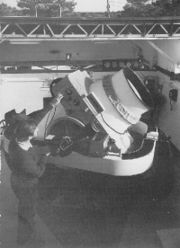
A lack of good data about the debris problem prompted a series of studies to better characterize the LEO environment. In October 1979 NASA provided Kessler with additional funding for further studies of the problem.[15]
Several approaches were used by these studies. Some used optical telescopes or short-wavelength radars to more accurately measure the number and size of objects in space. The optical measurements alone demonstrated that the published population count was too low by at least 50%.[17] Before this it was believed that the NORAD database was essentially complete and accounted for at least the majority of large objects in orbit. These measurements demonstrated that the NORAD list deliberately eliminated some objects (typically U.S. military spacecraft), could not easily account for objects under 20 centimetres (7.9 in) in size, and didn't bother to track many others because they were considered unimportant. In particular, the debris left over from exploding rocket boosters and several 1960s anti-satellite tests were only tracked in a haphazard way in the main database.[15]
Other studies used microscopes to study spacecraft that had returned to Earth, looking for impacts that had already taken place and had gone unnoticed. Sections of Skylab and the Apollo CSMs that had been recovered in the 1960s and '70s were shown to be heavily pitted by debris. To everyone's surprise, every study demonstrated that the debris flux was much higher than expected, and that debris was already the primary source of collisions in space. LEO was already suffering from the Kessler Syndrome, as originally defined.[15] Later refinements were added as the result of the return of Solar Max, the Long Duration Exposure Facility, numerous Space Shuttle missions, and similar spacecraft studies. Similar studies continue to this day.
One discovery that was particularly disconcerting was that 42% of all cataloged debris was the result of only 19 events, explosions of spent rocket stages, mostly from U.S. Deltas.[18] Kessler made this discovery after using Gabbard's methods against known debris fields, overturning the previously held belief that most unknown debris was from formerly unknown ASAT tests.[19] The Delta was a workhorse of the U.S. space program, and there were already numerous other Delta components in orbit that had not yet exploded.
A new Kessler Syndrome
During the same period, the US Air Force ran an experimental program to determine what would happen if debris collided with satellites or other debris. The study demonstrated that the process was entirely unlike the micrometeor case, and that many large chunks of debris would be created that would themselves be a collisional threat.[15] This leads to a worrying possibility – instead of the density of debris being a measure of the number of items launched into orbit, it was that number plus any new debris caused when they collided. If the new debris did not decay from orbit before impacting another object, the number of debris items would continue to grow even if there were no new launches.
In 1991 Kessler published a new work using the best data then available. In "Collisional cascading: The limits of population growth in low earth orbit" he mentioned the USAF's conclusions about the creation of debris. Although the vast majority of debris objects by number was lightweight, like paint flecks, the majority of the mass was in heavier debris, about 1 kilogram (2.2 lb) or heavier. This sort of mass would be enough to destroy any spacecraft on impact, creating more objects in the critical mass area.[20] As the National Academy of Sciences put it:
A 1-kg object impacting at 10 km/s, for example, is probably capable of catastrophically breaking up a 1,000-kg spacecraft if it strikes a high-density element in the spacecraft. In such a breakup, numerous fragments larger than 1 kg would be created.[21]
Kessler's analysis led to the conclusion that the problem could be categorized into three regimes. With a low enough density the addition of debris through impacts is lower than their rate of decay, and the problem does not become significant. Beyond that is a critical density where additional debris can quickly upset the system and lead to additional collisions. At a high enough density the rate of production is greater than decay rates, leading to a "cascade", or chain reaction, that quickly reduces the on-orbit population to small objects on the order of a few cm in size, making any sort of space activity very hazardous.[20] This worrying possibility became the new use of the term "Kessler Syndrome".[15]
In a historical overview written in early 2009, Kessler summed up the situation bluntly:
Aggressive space activities without adequate safeguards could significantly shorten the time between collisions and produce an intolerable hazard to future spacecraft. Some of the most environmentally dangerous activities in space include large constellations such as those initially proposed by the Strategic Defense Initiative in the mid-1980s, large structures such as those considered in the late-1970s for building solar power stations in Earth orbit, and anti-satellite warfare using systems tested by the USSR, the U.S., and China over the past 30 years. Such aggressive activities could set up a situation where a single satellite failure could lead to cascading failures of many satellites in a period of time much shorter than years.[15]
Debris growth
Faced with this potentially worrying scenario, as early as the 1980s NASA and other groups within the U.S. attempted to limit the growth of debris. One particularly effective solution was implemented by McDonnell Douglas on the Delta booster, by moving the boosters away from their payload and then venting any remaining fuel in the tanks. This eliminated the pressure build-up in the tanks that had caused them to explode in the past.[22] Other countries, however, were not as quick to adopt this sort of measure, and the problem continued to grow throughout the 1980s, especially due to a large number of launches in the Soviet Union.[23]
A new battery of studies followed as NASA, NORAD and others attempted to better understand exactly what the environment was like. Every one of these studies adjusted the number of pieces of debris in this critical mass zone upward. In 1981 when Schefter's article was published it was placed at 5,000 objects,[13] but a new battery of detectors in the Ground-based Electro-Optical Deep Space Surveillance system quickly found new objects within its resolution. By the late 1990s it was thought that the majority of 28,000 launched objects had already decayed and about 8,500 remained in orbit.[24] By 2005 this had been adjusted upward to 13,000 objects,[25] and a 2006 study raised this to 19,000 as a result of an ASAT test and a satellite collision.[26]
The population growth has led to intense debate within the community on the nature of the problem and earlier dire warnings. Following Kessler's 1991 derivation, and updates from 2001,[27] the LEO environment within the 1,000 kilometres (620 mi) altitude range should now be within the cascading region. However, only one major incident has occurred: the 2009 satellite collision between Iridium 33 and Cosmos 2251. The lack of any obvious cascading in the short term has led to a number of complaints that the original estimates overestimated the issue.[28] Others have pointed out that the start of a cascade would not be obvious until the situation was well advanced, which might take years.
A 2006 NASA model suggested that even if no new launches took place, the environment would continue to contain the then-known population until about 2055, at which point it would increase on its own.[29][30] Richard Crowther of Britain's Defence Evaluation and Research Agency stated that he believes the cascade will begin some time around 2015.[31] The National Academy of Sciences, summarizing the view among professionals, noted that there was widespread agreement that two bands of LEO space, 900 to 1,000 kilometres (620 mi) and 1,500 kilometres (930 mi) altitudes, were already past the critical density.[32]
Characterization
Large vs. small
Any discussion of space debris generally categorizes large and small debris. "Large" is defined not by its size so much as the current ability to detect objects of some lower size limit. Generally, large is taken to be 10 centimetres (3.9 in) across or larger, with typical masses on the order of 1 kilogram (2.2 lb).[33] Logically it would follow that small debris would be anything smaller than that, but in fact the cutoff is normally 1 centimetre (0.39 in) or smaller. Debris between these two limits would normally be considered "large" as well, but goes unmeasured due to our inability to track them.
In terms of numbers, the vast bulk of debris consists of smaller objects, 1 centimetre (0.39 in) or less. The mid-2009 update to the NASA debris FAQ places the number of large debris items over 10 centimetres (3.9 in) at 19,000, between 1 and 10 centimetres (3.9 in) approximately 500,000, and estimates that debris items smaller than 1 centimetre (0.39 in) probably exceeds tens of millions.[34] In terms of mass, the vast majority of the overall weight of the debris is concentrated in larger objects, using numbers from 2000, about 1,500 objects weighing more than 100 kilograms (220 lb) each account for over 98% of the 1,900 tons of debris then known in low earth orbit.[35]
Since space debris comes from man-made objects, the total possible mass of debris is easy to calculate: it is the total mass of all spacecraft and rocket bodies that have reached orbit. The actual mass of debris is much lower than that, as a considerable proportion of these objects have since decayed. As debris mass tends to be dominated by larger objects, most of which have long ago been detected, the total mass has remained relatively constant in spite of the addition of many smaller objects. Using the older figure of 8,500 known debris items, the total mass is estimated at 5,500 tonnes.[36]
Debris in LEO
Every satellite, space probe and manned mission has the potential to create space debris. Any impact between two objects of sizeable mass spalls off shrapnel debris from the force of collision. Each piece of shrapnel has the potential to cause further damage, creating even more space debris. With a large enough collision (such as one between a space station and a defunct satellite), the amount of cascading debris could be enough to render Low Earth Orbit essentially unusable.[15]
The problem in LEO is compounded by the fact that there are few "universal orbits" that keep spacecraft in particular rings, as opposed to GEO, a single widely-used orbit. The closest would be the sun-synchronous orbits that maintain a constant angle between the sun and orbital plane. But LEO satellites are in many different orbital planes providing global coverage, and the 15 orbits per day typical of LEO satellites results in frequent approaches between object pairs. Since sun-synchronous orbits are polar, the polar regions are common crossing points.[37]
After space debris is created, orbital perturbations mean that the orbital plane's direction will change over time, and thus collisions can occur from virtually any direction. Collisions thus usually occur at very high relative velocities, typically several kilometres per second.[38] Such a collision will normally create large numbers of objects in the critical size range, as was the case in the 2009 collision. It is for this reason that the Kessler Syndrome is most commonly applied only to the LEO region. In this region a collision will create debris that will cross other orbits and this population increase that leads to the cascade effect.
At the most commonly-used low earth orbits for manned missions, 400 kilometres (250 mi) and below, residual air drag helps keep the zones clear. Collisions that occur under this altitude are also less of an issue, since they result in fragment orbits having perigee at or below this altitude. The critical altitude also changes as a result of the space weather environment, which causes the upper atmosphere to expand and contract. An expansion of the atmosphere leads to an increased drag to the fragments, resulting in a shorter orbit life time. An expanded atmosphere for some period of time in the 1990s is one reason the orbital debris density remained lower for some time.[17] Another is the rapid reduction in launches by Russia, which conducted the vast majority of launches during the 1970s and 80s.[39]
Debris at higher altitudes
At higher altitudes, where atmospheric drag is less significant, orbital decay takes much longer. Slight atmospheric drag, lunar perturbations, and solar radiation pressure can gradually bring debris down to lower altitudes where it decays, but at very high altitudes this can take millennia.[40] Thus while these orbits are generally less used than LEO, and the problem onset is slower as a result, the numbers progress toward the critical threshold much more quickly.
The problem is especially problematic in the valuable geostationary orbits (GEO), where satellites are often clustered over their primary ground "targets" and share the same orbital path. Orbital perturbations are significant in GEO. Active satellites maintain their station via thrusters, but if they become inoperable they become a collision concern (as in the case of Telstar 401). There has been estimated to be one close (within 50 meters) approach per year.[41]
On the upside, relative velocities in GEO are low, compared with those between objects in largely random low earth orbits. The impact velocities peak at about 100 metres per second (330 ft/s).[42] This means that the debris field from such a collision is not the same as a LEO collision and does not pose the same sort of risks, at least over the short term. It would, however, almost certainly knock the satellite out of operation. Large-scale structures, like solar power satellites, would be almost certain to suffer major collisions over short periods of time.[43]
In response, the ITU has placed increasingly strict requirements on the station-keeping ability of new satellites and demands that the owners guarantee their ability to safely move the satellites out of their orbital slots at the end of their lifetime. However, studies have suggested that even the existing ITU requirements are not enough to have a major effect on collision frequency.[44] Additionally, GEO orbit is too distant to make accurate measurements of the existing debris field for objects under 1 metre (3 ft 3 in), so the precise nature of the existing problem is not well known.[45] Others have suggested that these satellites be moved to empty spots within GEO, which would require less maneuvering and make it easier to predict future motions.[46] An additional risk is presented by satellites in other orbits, especially those satellites or boosters left stranded in geostationary transfer orbit, which are a concern due to the typically large crossing velocities.
In spite of these efforts at risk reduction, spacecraft collisions have taken place. Olympus was hit by a meteor on 11 August 1993 and left adrift.[47] On 24 July 1996, Cerise, a French microsatellite in a sun-synchronous LEO, was hit by fragments of an Ariane-1 H-10 upper-stage booster that had exploded in November 1986.[19] On 29 March 2006, the Russian Express-AM11 communications satellite was struck by an unknown object which rendered it inoperable. Luckily, the engineers had enough time in contact with the spacecraft to send it to a parking orbit out of GEO.[48]
Sources of debris
Spent rocket upper stages and abandoned satellites are only the tip of the iceberg as far as the space debris population is concerned. There are a number of processes and events that generate new debris objects. Events that lead to the generation of space debris are on-orbit explosions or collisions, firings of solid rocket motors, releases of RORSAT reactor coolant, the release of mission-related objects (such as covers for optical instruments, or yo-yo de-spin weights), and impacts of micrometeorids or small space debris onto spacecraft. Processes that lead to the generation of new debris are the degradation of spacecraft surfaces and the delamination of objects due to the influence of the radiation environment in space.
Dead spacecraft
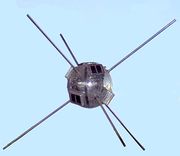
In 1958 the United States launched Vanguard I into a Medium Earth orbit (MEO). It became one of the longest surviving pieces of space junk and as of October 2009[update] remains the oldest piece still in orbit.[49]
In a catalog listing known launches up to July 2009, the Union of Concerned Scientists listed 902 operational satellites.[50] This is out of a known population of 19,000 large objects and about 30,000 objects ever launched. Thus, operational satellites represent a small minority of the population of man-made objects in space. The rest are, by definition, debris.
One particular series of satellites presents an additional concern. During the 1970s and 80s the Soviet Union launched a number of naval surveillance satellites as part of their RORSAT program. As radar returns fall off with the fourth power, in order to obtain useful returns the satellites were powered with a BES-5 nuclear reactor in order to provide enough energy to the broadcaster. The satellites were normally boosted into a medium altitude graveyard orbit, but there were several failures that resulted in radioactive material reaching the ground (see Kosmos 954 and Kosmos 1402). Even those successfully disposed of now face a debris issue of their own, with a calculated probability of 8% that one will be punctured and release its coolant over any 50 year period. The coolant self-forms into droplets up to around some centimeters in size[51] and these represent a significant debris source of their own.[52]
In February 2009, a US satellite collided with a defunct Russian satellite over Siberia.[53]
Lost equipment
Debris is also commonly caused during space-walks. According to Edward Tufte's book Envisioning Information, space debris objects have included a glove lost by astronaut Ed White on the first American space-walk (EVA); a camera Michael Collins lost near the spacecraft Gemini 10; garbage bags jettisoned by the Soviet cosmonauts throughout the Mir space station's 15-year life;[49] a wrench and a toothbrush. Sunita Williams of STS-116 also lost a camera during EVA. In an EVA to reinforce a torn solar panel during STS-120, a pair of pliers was lost and during STS-126, Heidemarie Stefanyshyn-Piper lost a briefcase-sized tool bag in one of the mission's EVAs.[54]
Boosters
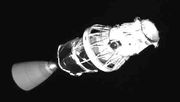
Lower stages, like the solid rocket boosters of the Space Shuttle, or the Saturn IB stage of the Apollo program era, do not reach orbital velocities and do not add to the mass load in orbit.[55] Upper stages, like the Inertial Upper Stage, start and end their productive lives in orbit. Boosters remain a serious debris problem and one of the major known impact events was due to an Ariane booster.[19]
During the initial attempts to characterize the space debris problem, it became evident that a good proportion of all debris was due to the breaking up of rocket boosters. Although NASA quickly made efforts to improve the survivability of their boosters, other countries did not follow suit for some time. On 11 March 2000, a Chinese Long March 4's CBERS-1/SACI-1 upper stage exploded in orbit and created a debris cloud.[56][57]
An event of similar magnitude occurred on 19 February 2007, when a Russian Briz-M booster stage exploded in orbit over South Australia. The booster had been launched on 28 February 2006, carrying an Arabsat-4A communication satellite but malfunctioned before it could use all of its fuel. The explosion was captured on film by several astronomers, but due to the path of the orbit the debris cloud has been hard to quantify using radar. As of 21 February 2007, over 1,000 fragments had been identified.[58][59] A third break-up event also occurred on 14 February 2007 as recorded by Celes Trak.[60] Eight break-ups occurred in 2006, the most break-ups since 1993.[61]
Debris from and as a weapon
One major source of debris in the past was the testing of anti-satellite weapons carried out by both the U.S. and Soviet Union in the 1960s and '70s. The NORAD element files only contained data for Soviet tests, and it was not until much later that debris from U.S. tests was identified.[13] By the time the problem with debris was understood, widespread ASAT testing had ended. The U.S.'s only active weapon, Program 437, was shut down in 1975.[62]
The U.S. re-started their ASAT programs in the 1980s with the Vought ASM-135 ASAT. A 1985 test destroyed a 1 tonne (2,200 lb) satellite orbiting at 525 kilometres (326 mi) altitude, creating thousands of pieces of space debris larger than 1 centimetre (0.39 in). Because it took place at relatively low altitude, atmospheric drag caused the vast majority of the large debris to decay from orbit within a decade. Following the U.S. test in 1985, there was a de-facto moratorium on such tests.[63]

China suffered widespread condemnation after their 2007 anti-satellite missile test, both for the military implications as well as the huge amount of debris it created.[64] This is the largest single space debris incident in history, estimated to have created more than 2,300 pieces (updated 13 December 2007) of trackable debris (approximately golf ball size or larger), over 35,000 pieces 1 cm (0.4 in) or larger, and 1 million pieces 1 mm (0.04 in) or larger. Particularly worrying is the fact that the test took place in the most densely populated part of space, as the target satellite orbited between 850 kilometres (530 mi) and 882 kilometres (548 mi).[65] Since the atmospheric drag is quite low at that altitude, the debris will persist for decades. In June 2007, NASA's Terra environmental spacecraft was the first to perform a maneuver in order to prevent impacts from this debris.[66]
On 20 February 2008, the U.S. launched an SM-3 Missile from the USS Lake Erie specially to destroy a defective U.S. spy satellite feared to be carrying 1,000 pounds of toxic hydrazine fuel. Since this event occurred at about 250 km (155 mi) altitude, all of the resulting debris have a perigee of 250 km (155 mi) or lower.[67] The missile was aimed to deliberately reduce the amount of debris as much as possible, and they had decayed by early 2008.[68]
The vulnerability of satellites to a collision with larger debris and the ease of launching such an attack against a low-flying satellite, has led some to speculate that such an attack would be within the capabilities of countries unable to make a precision attack like former U.S. or Soviet systems. Such an attack against a large satellite of 10 tonnes or more would cause enormous damage to the LEO environment.[63]
Operational aspects
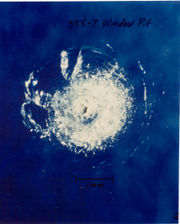
The vast majority of space debris consists of small particles, from microns up to 1 centimetre (0.39 in). Although there are an estimated 100 million such particles in orbit, they represent a tiny fraction of the total mass of human-made objects in space: perhaps 1%. On impact, these particles cause damage similar to that from a micrometeorite and the widespread use of Whipple shields is effective against the damage they would otherwise cause. Many parts of spacecraft, however, cannot be protected with Whipple shields and are subject to constant wear and tear.
As these sorts of smaller debris represent the minority of the mass, and cause little damage, much of the focus on space debris risks centres on larger debris. The exact definition of "larger" generally means "the size that can be tracked using current technology" and thus changes as tracking technologies improve. In general, these objects are on the order of 10 centimetres (3.9 in) or larger and mass from about 1 kilogram (2.2 lb) and up. Collision with a fragment of this size at the average speed of 10 kilometres per second (6.2 mi/s) would be catastrophic. As a result, space missions have to consider a number of operational factors and risk mitigation strategies.
Threat to unmanned spacecraft
Spacecraft in a debris field are subject to constant wear as a result of impacts with small debris. Critical areas of a spacecraft are normally protected by Whipple shields, eliminating most damage. However, low-mass impacts have a direct impact on the lifetime of a space mission, if the spacecraft is powered by solar panels. These panels are difficult to protect because their front face has to be directly exposed to the sun. As a result, they are often punctured by debris. When hit, panels tend not to produce new debris as much as a cloud of gas-sized particles that does not present as much of a risk to other spacecraft. This gas is generally a plasma when created and consequently presents an electrical risk to the panels themselves.[69] Olympus was rendered effectively dead after such a collision, although this was from a Perseid meteor, not spacecraft debris.[70]

The effect of the many impacts with smaller debris was particularly notable on Mir, the Soviet space station, as it remained in space for long periods of time with the panels originally launched on its various modules.[71][72]
Impacts with larger debris normally destroy the spacecraft. To date there have been several known and suspected impact events. The earliest on record was the loss of Kosmos 1275, which disappeared on 24 July 1981 only a month after launch. Tracking showed it had suffered some sort of breakup with the creation of 300 new objects. Kosmos did not contain any volatiles and is widely assumed to have suffered a collision with a small object. However, proof is lacking, and an electrical battery explosion has been offered as a possible alternative. Kosmos 1484 suffered a similar mysterious breakup on 18 October 1993.[73]
Several confirmed impact events have taken place since then. Olympus was hit by a meteor on 11 August 1993 and left adrift.[47] On 24 July 1996, the French microsatellite Cerise was hit by fragments of an Ariane-1 H-10 upper-stage booster that had exploded in November 1986.[19] On 29 March 2006 the Russian Express-AM11 communications satellite was struck by an unknown object which rendered it inoperable. Luckily, the engineers had enough time in contact with the spacecraft to send it to a parking orbit out of GEO.[48]
The first major space debris collision was on 10 February 2009 at 16:56 UTC. The deactivated 950 kilograms (2,100 lb) Kosmos 2251 and an operational 560 kilograms (1,200 lb) Iridium 33 collided 500 miles (800 km)[74] over northern Siberia. The relative speed of impact was about 11.7 kilometres per second (7.3 mi/s), or approximately 42,120 kilometres per hour (26,170 mph).[75] Both satellites were destroyed and the collision scattered considerable debris, which poses an elevated risk to spacecraft.[76] The collision created a debris cloud, although accurate estimates of the number of pieces of debris is not yet available.[77]
In a Kessler Syndrome cascade, satellite lifetimes would be measured on the order of years or months. New satellites could be launched through the debris field into higher orbits or placed in lower ones where natural decay processes remove the debris, but it is precisely because of the utility of the orbits between 800 and 1,500 kilometres (930 mi) that this region is so filled with debris.
Threat to manned spacecraft
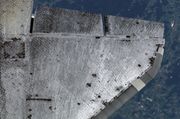
From the earliest days of the Space Shuttle missions, NASA has turned to NORAD's database to constantly monitor the orbital path in front of the Shuttle to find and avoid any known debris. At one point these simulations used up a considerable amount of the NORAD tracking system's capacity.[22] The first official Space Shuttle collision avoidance maneuver was during STS-48 in September 1991.[78] A 7-second reaction control system burn was performed to avoid debris from the Cosmos satellite 955. Similar maneuvers followed on missions 53, 72 and 82.[78]
One of the first events to widely publicize the debris problem was Space Shuttle Challenger's first flight on STS-7. A small fleck of paint impacted Challenger's front window and created a pit over 1 millimetre (0.04 in) wide. Endeavour suffered a similar impact on STS-59 in 1994, but this one pitted the window for about half its depth: a cause for much greater concern. Post-flight examinations have noted a marked increase in the number of minor debris impacts since 1998.[79]
The damage due to smaller debris has now grown to become a significant threat in its own right. Chipping of the windows became common, along with minor damage to the thermal protection system tiles (TPS). To mitigate the impact of these events, once the Shuttle reaches orbit it is deliberately flown tail first in an attempt to intercept as much of the debris load as possible on the engines and rear cargo bay. These are not used on orbit or during descent and thus are less critical to operations after launch. When flown to the ISS, the Shuttle is moved to a location where the station itself provides as much protection as possible.[80]
The sudden increase in debris load led to a re-evaluation of the debris issue and today a catastrophic impact with large debris is considered to be the #1 threat to Shuttle operations on every mission.[80][81] Mission planning now requires a thorough discussion of debris risk, requiring an executive level decision to proceed if the risk is greater than 1 in 200 of destroying the Shuttle. On a normal low-orbit mission to the ISS the risks are estimated to be 1 in 300, but the STS-125 mission to repair the Hubble Space Telescope at 350 miles was initially calculated at 1 in 185 due to the 2009 satellite collision, and threatened to cancel the mission. However, a re-analysis as better debris numbers became available reduced this to 1 in 221, and the mission was allowed to proceed.[82]
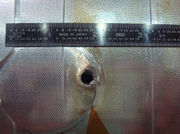
In spite of their best efforts, however, there have been two serious debris incidents on more recent Shuttle missions. In 2006, Atlantis was hit by a small fragment of a circuit board during STS-115, which bored a small hole through the radiator panels in the cargo bay (the large gold colored objects visible when the doors are open).[83] A similar incident followed on STS-118 in 2007, when Endeavour was hit in a similar location by unknown debris which blew a hole several centimetres in diameter through the panel.[84]
The International Space Station (ISS) uses extensive Whipple shielding to protect itself from minor debris threats.[85] However, large portions of the ISS cannot be protected, notably its large solar panels. In 1989 it was predicted that the International Space Station's panels would suffer about 0.23% degradation over four years, which was dealt with by overdesigning the panel by 1%.[86] New figures based on the increase in collisions since 1998 are not available.
Like the Shuttle, the only protection against larger debris is avoidance. On one occasion the crew was forced to abandon work and take refuge in the Soyuz capsule while the threat passed.[87] This close call is a good example of the potential Kessler Syndrome; the debris is believed to be a small 10 centimetres (3.9 in) portion of the former Cosmos 1275,[88] which is the satellite that is considered to be the first example of an on-orbit impact with debris.
If the Kessler Syndrome comes to pass, the threat to manned missions may be too great to contemplate operations in LEO. Although the majority of manned space activies take place at altitudes below the critical 800 to 1,500 kilometres (310 mi) regions, a cascade within these areas would result in a constant rain down into the lower altitudes as well. The time scale of their decay is such that "the resulting debris environment is likely to be too hostile for future space use."[20]
Hazard on Earth
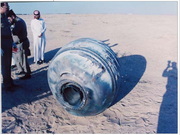
Although most debris will burn up in the atmosphere, larger objects can reach the ground intact and present a risk.
The original re-entry plan for Skylab called for the station to remain in space for 8 to 10 years after its final mission in February 1974. Unexpectedly high solar activity pushed the space station's orbit closer to Earth than planned. On 11 July 1979, Skylab re-entered the Earth's atmosphere and disintegrated, raining debris harmlessly along a path extending over the southern Indian Ocean and sparsely populated areas of Western Australia.[89][90]
On 12 January 2001, a Star 48 Payload Assist Module (PAM-D) rocket upper stage re-entered the atmosphere after a "catastrophic orbital decay".[91] The PAM-D stage crashed in the sparsely populated Saudi Arabian desert. It was positively identified as the upper-stage rocket booster for NAVSTAR 32, a GPS satellite launched in 1993.
The Columbia disaster in 2003 demonstrated this risk, as large portions of the spacecraft reached the ground. In some cases entire equipment systems were left intact.[92] NASA continues to warn people to avoid contact with the debris due to the possible presence of hazardous chemicals.[93]
On 27 March 2007, wreckage from a Russian spy satellite was spotted Lan Chile (LAN Airlines) Airbus A340, which was travelling between Santiago, Chile, and Auckland, New Zealand carrying 270 passengers.[94] The pilot estimated the debris was within 8 km of the aircraft, and he reported hearing the sonic boom as it passed.[95] The aircraft was flying over the Pacific Ocean, which is considered one of the safest places in the world for a satellite to come down because of its large areas of uninhabited water.
There has only been one recorded incident of a person being hit by human-made space debris. In 1997 an Oklahoma woman named Lottie Williams was hit in the shoulder by a 10 x 13 centimetres (5.1 in) piece of blackened, woven metallic material that was later confirmed to be part of the fuel tank of a Delta II rocket which had launched a U.S. Air Force satellite in 1996. She was not injured.[96]
Tracking and measurement
Tracking from the ground
Radar and optical detectors such as lasers are the main tools used for tracking space debris. However, determining orbits to allow reliable re-acquisition is problematic. Tracking objects smaller than 10 cm (4 in) is difficult due to their small cross-section and reduced orbital stability, though debris as small as 1 cm (0.4 in) can be tracked.[97][98] NASA Orbital Debris Observatory tracked space debris using a 3 m (10 ft) liquid mirror transit telescope.[99]
The U.S. Strategic Command maintains a catalogue containing about 19,000 objects in the version compiled in 2009, in part to prevent misinterpretation as hostile missiles. Observation data gathered by a number of ground-based radar facilities and telescopes as well as by a space-based telescope is used to maintain this catalogue.[100] Nevertheless, the majority of debris objects remain unobserved. There are more than 600,000 objects larger than 1 cm (0.4 in) in orbit (according to the ESA Meteoroid and Space Debris Terrestrial Environment Reference, the MASTER-2005 model).
Other sources of knowledge on the actual space debris environment include measurement campaigns by the ESA Space Debris Telescope, TIRA (System),[101] Goldstone radar, Haystack radar,[102] and the Cobra Dane phased array radar.[103] The data gathered during these campaigns is used to validate models of the debris environment like ESA-MASTER. Such models are the only means of assessing the impact risk caused by space debris, as only larger objects can be regularly tracked.
Measurement in space
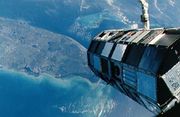
Returned space debris hardware is also a valuable source of information on the (sub-millimetre) space debris environment. The LDEF satellite deployed by STS-41-C Challenger and retrieved by STS-32 Columbia spent 68 months in orbit. The close examination of its surfaces allowed the analysis of the directional distribution and the composition of debris flux. The EURECA satellite deployed by STS-46 Atlantis in 1992 and retrieved by STS-57 Endeavour in 1993 could provide additional insight.
The solar arrays of the Hubble Space Telescope returned during missions STS-61 Endeavour and STS-109 Columbia are an important source of information on the debris environment. The impact craters found on the surface were counted and classified by ESA to provide another means for validating debris environment models. Similar materials returned from Mir were also extensively studied.
Gabbard diagrams
Space debris groups resulting from satellite breakups are often studied using scatter plots known as Gabbard diagrams. In a Gabbard diagram, the perigee and apogee altitudes of the individual debris fragments resulting from a collision are plotted with respect to the orbital period of each fragment. The distribution of the resulting diagram can be used to infer information such as direction and point of impact.[104][105]
Dealing with debris
In the 2009 European Air and Space Conference, University of Southampton, UK researcher, Hugh Lewis predicted that the threat from space debris would rise 50 percent in the coming decade and quadruple in the next 50 years. Currently more than 13,000 close calls are tracked weekly.[106]
Growth mitigation
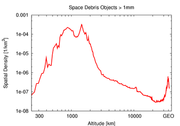
In order to mitigate the generation of additional space debris, a number of measures have been proposed. The passivation of spent upper stages by the release of residual fuels is aimed at reducing the risk of on-orbit explosions that could generate thousands of additional debris objects. The previously mentioned change to the Delta boosters in the early days of the debris characterization essentially eliminated their future contribution.[22]
There is no international treaty mandating behavior to minimize space debris, but the United Nations Committee on the Peaceful Uses of Outer Space (COPUOS) did publish voluntary guidelines in 2007.[107] As of 2008, the committee is discussing international "rules of the road" to prevent collisions between satellites.[108] NASA has implemented its own procedures for limiting debris production[109] as have some other space agencies, such as the European Space Agency. The ISO is also in the process of preparing a new standard, dealing with space debris mitigation.
Self-removal
It is already an ITU requirement that geostationary satellites be able to remove themselves to a "graveyard orbit" at the end of their lives. It has been demonstrated that the selected orbital areas do not sufficiently protect GEO lanes from debris, although a response has not yet been formulated.[44]
Rocket boosters and some satellites retain enough fuel to allow them to power themselves into a decaying orbit. In cases when a direct (and controlled) de-orbit would require too much fuel, a satellite can also be brought to an orbit where atmospheric drag would cause it to de-orbit after some years. Such a maneuver was successfully performed with the French Spot-1 satellite, bringing its time to atmospheric re-entry down from a projected 200 years to about 15 years by lowering its perigee from 830 km (516 mi) to about 550 km (342 mi).[110]
Another proposed solution is to attach an electrodynamic tether to the spacecraft on launch. At the end of their lifetime it is rolled out and slows down the spacecraft.[111] Although tethers of up to 30 km have been successfully deployed in orbit the technology has not yet reached maturity.[30] It has also been proposed that booster stages include a sail-like attachment to the same end.[112]
External removal
The vast majority of space debris, especially smaller debris, cannot be removed under its own power. A variety of proposals have been made to directly remove such material from orbit. One of the most widely discussed solutions is the laser broom, which uses a powerful ground-based laser to ablate the front surface off known debris and thereby produce a working mass that slows the debris in orbit. With a continued application of such thrust, the debris will eventually spiral down into a low orbit and become subject to atmospheric drag.[113]
The US Air Force worked on a ground-based design under the name "Project Orion".[114] Although a test-bed device was scheduled to launch on a 2003 Space Shuttle, numerous international agreements, forbidding the testing of powerful lasers in orbit, caused the program to be limited to using the laser as a measurement device.[115] In the end, the Space Shuttle Columbia disaster led to the project being postponed and, as Nicholas Johnson, Chief Scientist and Program Manager for NASA's Orbital Debris Program Office, later noted, "There are lots of little gotchas in the Orion final report. There's a reason why it's been sitting on the shelf for more than a decade."[116]
Another well-studied solution is to use a remotely controlled vehicle to rendezvous with debris, capture it, and return to a central station.[117] A number of other proposals intercept the debris in a foamy ball of aerogel or even a spray of water.[118] These would impact with the debris and slow it down. Some propose inflating balloons around the objects in order to increase their atmospheric drag. However, it was pointed out that a balloon could be punctured by other debris, thereby failing in its mission and actually increasing the amount of mass in orbit.
In any event, the cost of launching any of these solutions is about the same as launching any spacecraft. Johnson has stated that none of the existing solutions are currently cost-effective.[30]
Star Inc. has proposed an ElectroDynamic Debris Eliminator (EDDE) vehicle which using an electrodynamic tether for propulsion and orbit tranfers, can clean up LEO space debris using lightweight nets. Each vehicle is 100 kg, and packs into 24”x24”x12”. They claim that 12 EDDEs can remove all 2465 cataloged LEO objects >2 kg in 7 years.[119] In January 7, 2010 Star Inc. announced that it has won a contract from Navy/SPAWAR for a feasibility study of the application of the ElectroDynamic Debris Eliminator (EDDE).[120]
Space debris in popular culture
The problems caused by space debris is a major theme in the Manga / Anime Planetes. In this series, the protagonists are employed as debris collectors, operating from a space station.[121]
In the computer-animated film WALL-E, the scene in which the two main characters are leaving an over-polluted Earth shows their spacecraft passing through a belt of orbiting debris.[122]
In Peter F. Hamilton's Fallen Dragon, the inhabitants of the planet Santa Chico deliberately destroy their own moon in order to create an ablation cascade to deny the use of space to the invading forces of the Zantiu-Braun mega-corporation.[123]
Cowboy Bebop also features space debris orbiting Earth.
The 2000s television series Dead Like Me follows the afterlife of a young woman after she is killed by a falling piece of space debris, specifically a toilet seat from Mir.
An episode of the television series UFO titled "Conflict" featured a hostile UFO hiding amidst space junk in low Earth orbit, and Commander Ed Straker demanding a "clearance program" for the debris. This can be considered prescient since the episode was first aired in 1970, and the events of the series were said to occur around 1980.
A Codex (encyclopedia) entry in the video game Mass Effect states that due to excessive debris from early space exploration activities, ships are strongly advised to employ kinetic barriers (force fields) near Earth.
In the video game Shattered Horizon, the partial destruction of the moon has creating a massive ring of debris around the Earth, mostly consisting of moon rock. According to the game, this large amount of debris makes it difficult to impossible to launch any space craft into orbit. It focuses on those astronauts stuck in orbit, as well as the miners who caused the catastrophe.
In 1997, British new wave rock band Wang Chung released the single Space Junk on its compilation album Everybody Wang Chung Tonight: Wang Chung's Greatest Hits.
See also
- 2009 satellite collision
- J002E3
- 6Q0B44E
- Near-Earth object
- Liability Convention
- Orbital Debris Co-ordination Working Group
- Registration Convention
- Space archaeology
References
Notes
- ↑ 1.0 1.1 Oswald, M., S. Stabroth, C. Wiedemann, P. Wegener and C. Martin: "Upgrade of the MASTER Model", Final Report of ESA Contract No. 18014/03/D/HK(SC), Braunschweig, 2006.
- ↑ Fred Whipple, "The Theory of Micro-Meteorites, Part I: In an Isothermal Atmosphere", Proceedings of the National Academy of Sciences, Volume 36 Number 12 (15 December 1950), pg. 667-695
- ↑ Whipple, Fred. "The Theory of Micrometeorites." Popular Astronomy, Volume 57, 1949, p. 517.
- ↑ Whipple, Fred. "A Comet Model. II. Physical Relations for Comets and Meteors." Astrophysical Journal, Volume 113, 1951, pp. 464–474.
- ↑ Brownlee, D. E. , D. A. Tomandl and E. Olszewski. "Interplanetary dust: A new source of extraterrestrial material for laboratory studies." Proceedings of the 8th Lunar Scientific Conference, pp. 149–160.
- ↑ Pettersson, Hans. "Cosmic Spherules and Meteoritic Dust." Scientific American, Volume 202 Issue 2, February 1960, pp. 123–132.
- ↑ Snelling, Andrew and David Rush. "Moon Dust and the Age of the Solar System." Creation Ex-Nihilo Technical Journal, Volume 7, Number 1, 1993, p. 242.
- ↑ "Professor Fred Whipple: Astronomer who developed the idea that comets are 'dirty snowballs'." The Independent, 13 November 2004
- ↑ Whipple, Fred. "Of Comets and Meteors." Science, Volume 289, Number 5480, 4 August 2000, p. 728.
- ↑ Kessler, Donald. "Upper Limit on the Spatial Density of Asteroidal Debris." AIAA Journal, Volume 6 Number 12, December 1968, p. 2450.
- ↑ 11.0 11.1 11.2 Kessler 1971
- ↑ Hoots, Felix, Paul Schumacher Jr. and Robert Glover. "History of Analytical Orbit Modeling in the U. S. Space Surveillance System." Journal of Guidance Control and Dynamics, Volume 27, Issue 2, pp. 174–185.
- ↑ 13.0 13.1 13.2 Schefter 1982, p. 48.
- ↑ Kessler 1978
- ↑ 15.0 15.1 15.2 15.3 15.4 15.5 15.6 15.7 15.8 15.9 Kessler 2009
- ↑ Schefter 1982
- ↑ 17.0 17.1 Kessler 1991, p. 65.
- ↑ Kessler 1981
- ↑ 19.0 19.1 19.2 19.3 Klinkrad, p. 2.
- ↑ 20.0 20.1 20.2 Kessler 1991, p. 63.
- ↑ "Orbital Debris: A Technical Assessment" 1995, p. 4
- ↑ 22.0 22.1 22.2 Schefter 1982, p. 50.
- ↑ See charts, Hoffman p. 7
- ↑ See chart, Hoffman p. 4.
- ↑ In the time between writing Chapter 1 (earlier) and the Prolog (later) of Space Debris, Klinkrad changed the number from 8,500 to 13,000 - compare pg. 6 and ix.
- ↑ Hoffman, Michael. "It's getting crowded up there." Space News, 3 April 2009.
- ↑ Kessler 2001
- ↑ "Orbital Debris: A Technical Assessment" 1995
- ↑ Liou, J.-C., and N. L. Johnson: "Risks in Space from Orbiting Debris", Science, 20 January 2006, Vol. 311. no. 5759, pp. 340 - 341
- ↑ 30.0 30.1 30.2 Lovgren, Stefan. "Space Junk Cleanup Needed, NASA Experts Warn." National Geographic News, 19 January 2006.
- ↑ Milne, Antony. Sky Static: The Space Debris Crisis. Santa Barbara, CA: Greenwood Publishing Group, 2002, p. 86.
- ↑ "Orbital Debris: A Technical Assessment" 1995, p. 7.
- ↑ Technical report on space debris, United Nations, New York, 1999.
- ↑ "Orbital Debris FAQ: How much orbital debris is currently in Earth orbit?" NASA, July 2009.
- ↑ Carroll, Joseph. "Space Transport Development Using Orbital Debris." niac.usra.edu, 2 December 2002, p. 3.
- ↑ McKie, Robin and Michael Day. "Warning of catastrophe from mass of 'space junk'." The Observer, 24 February 2008.
- ↑ Ford, Matt. "Orbiting space junk heightens risk of satellite catastrophes." Ars Technica, 27 February 2009.
- ↑ "What are hypervelocity impacts?" ESA, 19 February 2009.
- ↑ Klinkrad, p. 7.
- ↑ Kessler 1991, p. 268.
- ↑ "Colocation Strategy and Collision Avoidance for the Geostationary Satellites at 19 Degrees West." CNES Symposium on Space Dynamics, 6–10 November 1989.
- ↑ Hanada, T. "Developing a Low-Velocity Collision Model Based on the NASA Standard Breakup Model." Space Debris, Volume 2, Number 4, 2000, pp. 233–247.
- ↑ van der Ha, J. C. and M. Hechler. "The Collision Probability of Geostationary Satellites." 32nd International Astronautical Congress, 1981, p. 23.
- ↑ 44.0 44.1 Anselmo, L. and C. Pardini. "Collision Risk Mitigation in Geostationary Orbit." Space Debris, Volume 2, Number 2, June 2000, pp. 67–82.
- ↑ Orbital debris, p. 86.
- ↑ Orbital debris, p. 152.
- ↑ 47.0 47.1 "The Olympus failure." ESA press release, 26 August 1993.
- ↑ 48.0 48.1 "Notification for Express-AM11 satellite users in connection with the spacecraft failure." Russian Satellite Communications Company, 19 April 2006.
- ↑ 49.0 49.1 Smith, Julian. "Space Junk." USA Weekend, 26 August 2007.
- ↑ "UCS Satellite Database." Union of Concerned Scientists, 16 July 2009.
- ↑ Wiedemann, C., Flegel, S., Gelhaus, J., Klinkrad, H., Vörsmann, P., Size distribution of NaK droplets for MASTER-2009, Proc. '5th European Conference on Space Debris', Darmstadt, Germany, 30 March -- 2 April 2009, (ESA SP-672, July 2009).
- ↑ A. Rossi et all, "Effects of the RORSAT NaK Drops on the Long Term Evolution of the Space Debris Population", University of Pisa, 1997
- ↑ "Science & Environment | Russian and US satellites collide". BBC News. 2009-02-12. http://news.bbc.co.uk/2/hi/science/nature/7885051.stm. Retrieved 2010-08-16.
- ↑ See image here.
- ↑ In some cases they return to the ground intact, see this list for examples.
- ↑ Anz-Meador, Phillip and Mark Matney. "An assessment of the NASA explosion fragmentation model to 1 mm characteristic sizes." Advances in Space Research, Volume 34, Issue 5, 2004, pp. 987–992.
- ↑ "Debris from explosion of Chinese rocket detected by University of Chicago satellite instrument." University of Chicago press release, 10 August 2000.
- ↑ "Rocket Explosion." Spaceweather.com, 22 February 2007. Retrieved: 21 February 2007.
- ↑ Than, Ker. "Rocket Explodes Over Australia, Showers Space with Debris." Space.com, 21 February 2007. Retrieved: 21 February 2007.
- ↑ publisher=celestrak.com "Recent Debris Events." celestrak.com, 16 March 2007.
- ↑ "Spate of rocket breakups creates new space junk." NewScientist.com, 17 January 2007. Retrieved: 16 March 2007.
- ↑ Chun, Clayton. Shooting Down a Star: America's Thor Program 437, Nuclear ASAT, and Copycat Killers. Maxwell AFB Base, AL: Air University Press, 1999. ISBN 1-58566-071-X.
- ↑ 63.0 63.1 Wright, David. "Debris in Brief: Space Debris from Anti-Satellite Weapons." Union of Concerned Scientists, December 2007.
- ↑ David, Leonard. "China's Anti-Satellite Test: Worrisome Debris Cloud Circles Earth." space.com, 2 February 2007.
- ↑ "Fengyun 1C - Orbit Data." Heavens Above.
- ↑ Burger, Brian. "NASA's Terra Satellite Moved to Avoid Chinese ASAT Debris." space.com. Retrieved: 6 July 2007.
- ↑ "Pentagon: Missile Scored Direct Hit on Satellite." npr.org, 21 February 2008.
- ↑ Wolf, Jim. "US satellite shootdown debris said gone from space." uk.reuters.com, 27 February 2008.
- ↑ Akahoshi, Y. et al. "Influence of space debris impact on solar array under power generation." International Journal of Impact Engineering, Volume 35, Issue 12, December 2008, pp. 1678–1682.
- ↑ Grice, Corey. "Satellites hope to shake meteor shower." CNET News, 16 November 1998.
- ↑ Smirnov, V.M. et al. "Study of Micrometeoroid and Orbital Debris Effects on the Solar Panels Retrieved from the Space Station 'MIR'." Space Debris, Volume 2, Number 1, March, 2000, pp. 1–7.
- ↑ "Orbital Debris FAQ: How did the Mir space station fare during its 15-year stay in Earth orbit?" NASA, July 2009.
- ↑ Clark, Phillip. "Space Debris Incidents Involving Soviet/Russian Launches." friends-partners.org.
- ↑ Iannotta , Becky and Malik,Tariq, "U.S. Satellite Destroyed in Space Collision , space.com, 11 February 2009
- ↑ Marks, Paul. "Satellite collision 'more powerful than China's ASAT test." New Scientist, 13 February 2009. Note: The collision speed was 42,120 kilometres per hour (11.7 km/s).
- ↑ Iannotta, Becky. "U.S. Satellite Destroyed in Space Collision." Space.com, 11 February 2009. Retrieved: 11 February 2009.
- ↑ "2 big satellites collide 500 miles over Siberia." yahoo.com, 11 February 2009. Retrieved: 11 February 2009.
- ↑ 78.0 78.1 Matson, Rob. "Satellite Encounters." Visual Satellite Observer's Home Page.
- ↑ Christiansen, E. L., J. L. Hydeb and R. P. Bernhard. "Space Shuttle debris and meteoroid impacts." Advances in Space Research, Volume 34, Issue 5, 2004, pp. 1097–1103.
- ↑ 80.0 80.1 Kelly, John. "Debris is Shuttle's Biggest Threat." space.com, 5 March 2005.
- ↑ "Debris Danger." Aviation Week & Space Technology, Volume 169, Number 10, 15 September 2008, p. 18.
- ↑ Harwood, William. "Improved odds ease NASA's concerns about space debris." CBS News, 16 April 2009.
- ↑ "Investigation of Shuttle Radiator Micro-Meteoroid & Orbital Debris Damage."
- ↑ D. Lear, et all, "STS-118 Radiator Impact Damage", NASA
- ↑ Thoma, K., M. Wicklein and E. Schneider, D. Danesy (editor). Abstract "New Protection Concepts for Meteoroid / Debris Shields." Proceedings of the 4th European Conference on Space Debris (ESA SP-587), 18–20 April 2005 in Darmstadt, Germany, ESA/ESOC, August 2005, p. 445.
- ↑ Nahra, Henry. "Effect of Micrometeoroid and Space Debris Impacts on the Space Station Freedom Solar Array Surfaces." Presented at the 1989 Spring Meeting of the Materials Research Society, 24–29 April 1989, NASA TR-102287.
- ↑ "Junk alert for space station crew." BBC News, 12 March 2009.
- ↑ Haines, Lester. "ISS spared space junk avoidance manoeuvre." The Register, 17 March 2009.
- ↑ "NASA - Part I - The History of Skylab." NASA's Marshall Space Flight Center and Kennedy Space Center, 16 March 2009.
- ↑ "NASA - John F. Kennedy Space Center Story." NASA Kennedy Space Center, 16 March 2009.
- ↑ "PAM-D Debris Falls in Saudi Arabia," The Orbital Debris Quarterly News, Volume 6, Issue 2.
- ↑ "Debris Photos." NASA.
- ↑ "Debris Warning." NASA.
- ↑ Gibson, Jano. "Jet's flaming space junk scare.", The Sydney Morning Herald, 28 March 2007.
- ↑ "Space junk falls around airliner", AFP, 28 March 2007
- ↑ "Today in Science History." todayinsci.com. Retrieved: 8 March 2006.
- ↑ Mehrholz, D. et al. "Detecting, Tracking and Imaging Space Debris", ESA bulletin 109, February 2002
- ↑ Greene, Ben. "Laser Tracking of Space Debris.", Electro Optic Systems Pty
- ↑ "Orbital debris: Optical Measurements", NASA Orbital Debris Program Office
- ↑ Stokes, Grant H., Curt von Braun, Ramaswamy Sridharan, David Harrison, and Jayant Sharma. "The Space-Based Visible Program." MIT Lincoln Laboratory. Retrieved: 8 March 2006.
- ↑ Klinkrad, H. "Monitoring Space - Efforts Made by European Countries." fas.org. Retrieved: 8 March 2006.
- ↑ "MIT Haystack Observatory" haystack.mit.edu. Retrieved: 8 March 2006.
- ↑ "AN/FPS-108 COBRA DANE." fas.org. Retrieved: 8 March 2006.
- ↑ Portree, David and Joseph Loftus. "Orbital Debris: A Chronology." NASA, 1999, see p. 13.
- ↑ Whitlock, David O. "History of On-Orbit Satellite Fragmentations." NASA JSC, 2004 Note: "Gabbard diagrams of the early debris cloud prior to the effects of perturbations, if the data were available, are reconstructed. These diagrams often include uncataloged as well as cataloged debris data. When used correctly, Gabbard diagrams can provide important insights into the features of the fragmentation."
- ↑ Marks, Paul (October 2009). "Space debris threat to future launches". NewScientist. http://www.newscientist.com/article/dn18050-space-debris-threat-to-future-launches.html. Retrieved 2009-10-28.
- ↑ "UN Space Debris Mitigation Guidelines."
- ↑ Hitchens, Theresa. "COPUOS Wades into the Next Great Space Debate." The Bulletin of the Atomic Scientists, 26 June 2008.
- ↑ "Orbital Debris - Important Reference Documents."
- ↑ de Selding, Peter B. "CNES Begins Deorbiting Spot-1 Earth Observation Satellite." Space News, 20 February 2009.
- ↑ Christensen, Bill. "The Terminator Tether Aims to Clean Up Low Earth Orbit." space.com. Retrieved: 8 March 2006.
- ↑ Amos, Jonathan. "How satellites could 'sail' home." BBC News, 3 May 2009.
- ↑ Campbell, Jonathan. "Using Lasers in Space: Laser Orbital Debris Removal and Asteroid Deflection." Occasional Paper No. 20, Air University, Maxwell Air Force Base, December 2000.
- ↑ Bekey, Ivan. "Project Orion: Orbital Debris Removal Using Ground-Based Sensors and Lasers." Second European Conference on Space Debris, 1997, ESA-SP 393, p. 699.
- ↑ Mullins, Justin. "A clean sweep: NASA plans to carry out a spot of housework." New Scientist, 16 August 2000.
- ↑ Reichhardt, Tony , "Satellite Smashers." Air & Space Magazine, 1 March 2008.
- ↑ Carlson, Erika et al. "Final design of a space debris removal system", NASA/CR-189976, 1990.
- ↑ Michaels, Daniel. "A Cosmic Question: How to Get Rid Of All That Orbiting Space Junk?" Wall Street Journal, 11 March 2009.
- ↑ "Space Debris Removal". Star-tech-inc.com. http://www.star-tech-inc.com/id121.html. Retrieved 2010-08-16.
- ↑ "News". Star-tech-inc.com. http://www.star-tech-inc.com/id68.html. Retrieved 2010-08-16.
- ↑ "Planetes (TV)"
- ↑ "Space debris, a growing concern." Niemanwatchdog.org.
- ↑ Hamilton, Peter F. Fallen Dragon. New York: Aspect, 2002, p. 605. ISBN 978-0-446-52708-8.
Bibliography
- "Interagency Report on Orbital Debris, 1995." National Science and Technology Council, November 1995.
- Kessler, Donald. "Collisional Cascading: The Limits of Population Growth in Low Earth Orbit", Advances in Space Research, Volume 11, Number 12, 1991, pp. 63–66.
- Kessler, Donald. "Estimate of Particle Densities and Collision Danger for Spacecraft Moving Through the Asteroid Belt", Physical Studies of Minor Planets, NASA SP-267, 1971, pp. 595–605.
- Kessler, Donald. "The Kessler Syndrome." webpages.charter.net, 8 March 2009.
- Kessler, Donald. "Sources of Orbital Debris and the Projected Environment for Future Spacecraft", Journal of Spacecraft, Volume 16, Number 4, July–August 1981, pp. 357–360.
- Kessler, Donald and Burton Cour-Palais. "Collision Frequency of Artificial Satellites: The Creation of a Debris Belt." Journal of Geophysical Research, Volume 81, Number A6, 1 June 1978, pp. 2637–2646.
- Kessler, Donald and Phillip Anz-Meador. "Critical Number of Spacecraft in Low Earth Orbit: Using Fragmentation Data to Evaluate the Stability of the Orbital Debris Environment", Presented and the Third European Conference on Space Debris, March 2001.
- Klinkrad, Heiner. "Space Debris: Models and Risk Analysis." Springer-Praxis, 2006, ISBN 3-540-25448-X.
- "Orbital Debris: A Technical Assessment." National Academy of Sciences, 1995. ISBN 0-309-05125-8.
- Schefter, Jim. "The Growing Peril of Space Debris." Popular Science, July 1982, pp. 48–51.
- "Technical report on space debris, 1999", United Nations, 2006. ISBN 92-1-100813-1.
Further reading
- David, Leonard. "The Clutter Above", Bulletin of the Atomic Scientists, July/August 2005.
- McDaniel, Patrick. "A Methodology for Estimating the Uncertainty in the Predicted Annual Risk to Orbiting Spacecraft from Current or Predicted Space Debris Population." National Defense University, 1997.
- Smirnov, Nickolay. Space Debris: Hazard Evaluation and Mitigation. Boca Raton, FL: CRC Press, 2002, ISBN 0-415-27907-0.
- "What is Orbital Debris?", Center for Orbital and Reentry Debris Studies, Aerospace Corporation
External links
- NASA Orbital Debris Program Office
- ESA Space Debris Office
- "Space: the final junkyard", documentary film
- Would a Saturn-like ring system around planet Earth remain stable?
- EISACT Space Debris during the international polar year
- Intro to mathematical modeling of space debris flux
- SOCRATES: A free daily service predicting close encounters on orbit between satellites and debris orbiting Earth
- A summary of current space debris by type and orbit
- Space Junk Astronomy Cast episode #82, includes full transcript
- Paul Maley's Satellite Page - Space debris (with photos)
- Space Debris Illustrated: The Problem in Pictures